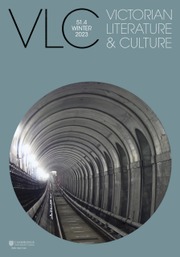Introduction
In Primitive Marriage: Victorian Anthropology, the Novel, and Sexual Modernity (2023), Kathy Psomiades shows us how Victorian novels and Victorian anthropology theorized modernity in sexual terms, using sexuality, as Psomiades puts it, to “tell what time it is,” locating cultures within histories of progress according to their visions of marriage and consent.Footnote 1 In her conclusion, as she considers how Victorian anthropology was both “recognized and made to disappear in twentieth-century theory,” she stresses the difficulty in deciphering, in seeing, narratives for what they really are and what they really do, particularly as new theories supplant prior modes of inquiry and explanation while simultaneously repurposing them, placing remnants of these past theories at their core while insisting upon the invalidity of previous modes of thought.Footnote 2 Freud’s separation of sex and social structure, for example, makes it difficult to see “Victorian anthropology of marriage as the systematic rethinking of political philosophy and political economy that it was,” and it makes it difficult to see “how this Victorian project anticipates and enables the post-Freudian late twentieth-century theoretical projects that return sexuality and gender to social theory and that still impact today’s theories of sex and time.”Footnote 3 Primitive Marriage preoccupies itself with untangling these narrative and theoretical knots, with illuminating things that are difficult to see. This is a book marked by deep curiosity about how our ways of knowing and thinking came to be as well as by a refusal to acquiesce to established stories about these cultural developments. Because it is so invested in rethinking that which is difficult to see, it seems to offer the possibility of new modes of interpretation, a shift in the kinds of stories we tell about the Victorian period and our own indebtedness and connectedness to its theoretical models.
Nathan Hensley and I invited a group of speakers to think together about what we might do with this book, how it might inflect the thinking we do moving forward, at the North American Victorian Studies Association conference in the fall of 2023. We have assembled those responses here along with a brief reply from Psomiades. In the proposal for this roundtable, Hensley stated that Psomiades’s subtlety of method enables us “to see old bad objects by new bright lights, and open up a host of tangled questions of sharp importance to Victorian studies now: about the relationship between theory and ideology; about the entanglement of the past with the present; about the function of racial and sexual difference in stories of liberal modernity; and about the ongoing purchase of Victorian socio-sexual categories beyond their moment of invention and deployment.”Footnote 4 The invited speakers emphasized in their comments Primitive Marriage’s potentially transformative impact on our field, its generation of what Talia Schaffer calls a “new kind of narrative” about sexual modernity and consent as well a new way of understanding the history of the novel. And they also stressed the openness and ethics of the book’s modes of analysis and argumentation. Rather than dismissing Victorian thought as bad ideology or treating the criticism and theory of the recent past as wrongheaded, her thinking is what Ian Duncan terms “responsible” or what Hensley refers to as “additive.” She comes to the nineteenth-century past with a real interest in its difference. She turns to the work of twentieth-century feminist critics writing about that past with an interest in building upon and supplementing rather than discarding. Her readings are, as Mary Jean Corbett notes, “incisive yet generous.” This, as Zachary Samalin argues, allows us to consider how we continue to think through nineteenth-century structures as we theorize sexual modernity or, as Psomiades puts it in her response to these assessments, how “our ideas remain Victorian.”
Primitive Marriage is, as these respondents note, also a pleasure to read. An enormous part of that has also to do with the book’s sense of humor, the extent to which Psomiades gets a kick out of the wildness of Victorian thought and how she invites you to see this thought with fresh eyes, to hold it to account for its strange ways of hating and categorizing but to also see the often unintended possibilities it might offer for other ways of being or theorizing. As she states in her response to this set of short essays, “Once the world was not as it is now,” and this past world is not to be only derided or condemned. It can certainly be engaged critically, but this engagement can also involve wonder as well as a consideration of the extent to which this past continues to operate within our present, inflecting the stories we tell and the frameworks we use to understand sex and modernity. There can be great pleasure, Primitive Marriage demonstrates, in looking at and puzzling through things that are difficult to see.


